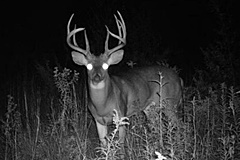
Welcome to Hemlock and Canadice Lakes!
Barns Businesses Cemeteries Churches Clinton & Sullivan Columns Communities Documents Events Time Line Fairs & Festivals Farm & Garden Hiking Homesteads Lake Cottages Lake Scenes Landscapes Library News Articles Old Maps Old Roads & Bridges Organizations People Photo Gallery Podcasts Railroad Reservoir Schools State Forest Veterans Videos
|
“Nature in the Little Finger Lakes” by Angela Cannon Crothers |
|
|
Where the Wildlife are By Angela Cannon Crothers August 2015 The creek was turbid with phytoplankton and swollen as if risen on yeast. We were paddling Honeoye Inlet, GPS in hand, searching for wildlife trip cameras that had been up for a few weeks this rainy summer at the Muller Field Station near the south end of Honeoye Lake. We wondered if any of the cameras might have ended up under water. “Look, right there,” said Sasha Mackenzie, a wildlife technician at Finger Lakes Community College, as she located the first camouflaged camera cache tied to a tree, just barely above the waterline. Back home we uploaded the disks on my computer, excited to see if they had actually caught any wildlife images or would merely reveal assorted shots triggered by branches swaying in the wind. In just one small hummock of creekside land appeared: a few shots of a raccoon followed by the perfect pose of a red fox, a pileated woodpecker flew in, raccoons again, then a deer. From behind the trees a black bear materialized in a series of approaching images until its mug practically filled the camera lens. Then: a family of geese and their goslins visited over several consecutive dusks, numerous shots of the painted mohawk of a wood duck two raccoons in a mating repose, and shots of otters over several days. The photos were a plethora of activity and visitations from just one small, five-foot-diameter area. It was amazing how much the cameras caught, but what made the biggest impression on me was just how much wildlife are actually around us going about their business of finding food, raising families, and traveling from place to place. Clearly, there’s a lot going on out there. I was driving - well, more like speeding - one quite late the other night along the dark highways with nothing more on my mind than getting there and to bed, when from the center line a red fox, kit in its jaw, sprinted so quickly in front of my vehicle it tossed the young off the road and leapt in a flash forward tumble into the grasses there. I had had no time to react. I vowed to slow down, keep my eyes peeled for animals, and drive like I cared about others. I saw two possums. Everywhere else there were deer crossing or shining their eyes from the roadside. Almost home, a large doe stood roadside, a lumpy form near her hooves along the white line. I pulled over and got out. She moved slowly into the wooded edge. There was her speckled fawn, probably dead for quite a while as he was a bit bloated and beginning to smell. I spoke out loud to the deer, telling her how sorry I was for her loss. I pulled her baby down the bank, much further from the roadside, making it safer for the mourning mother. I admit, I cried. The fact is this: we are not alone. The Finger Lakes area is teaming with animal brethren who share this lush landscape with us. This is their home, too, and they are part of what makes this area so special. I wonder how long it has been since we first developed such apathy regarding the dead along our roadsides. When did we give up on the feeling of horror and shame in such senseless killing? Maybe it was with the invention of fast-moving transportation. Slowing down is helpful, and being aware of our surroundings is probably even more so. But in some areas of the country (Florida in particular) highway departments are building wildlife culverts, underpasses, and greenway overpasses, connecting habitat and mitigating barriers to wildlife movement for amphibians, fish, and mammals. Like the images that Sasha and I had collected, I’ve seen trigger camera photos from these small corridors, and the animals really do use them. It’s like having faith that if you build it, they will come. Imagine, if our roadway trespasses had such safe routes for animals, how humane we humans could become.
|
||
|
Editor’s Note: Angela Cannon Crothers is a naturalist and writer who teaches at Finger Lakes Community College and with The Finger Lakes Museum. Here are some columns that she has written about the Little Finger Lakes. Her columns also appear in the Lake Country Weekender newspaper.
|
||
